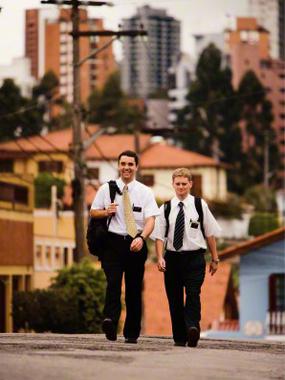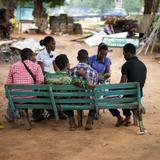The Church of Jesus Christ of Latter-day Saints' missionary program is one of its most recognized characteristics. Mormon missionaries can be seen on the streets of hundreds of major cities in the world as well as in thousands of smaller communities.
| 2018 by Intellectual Reserve, Inc. All rights reserved. | 1 / 3 |
The missionary effort is based on the New Testament pattern of missionaries serving in pairs, teaching the gospel and baptizing believers in the name of Jesus Christ (see, for example, the work of Peter and John in the book of Acts).
More than 70,000 full-time missionaries are serving missions for The Church of Jesus Christ of Latter-day Saints. Most missionaries are young people under the age of 25, serving in more than 400 missions throughout the world.
Missionaries work with a companion of the same gender during their mission, with the exception of couples, who work with their spouse. Single men serve missions for two years and single women serve missions for 18 months.
Missionaries receive their assignment from Church headquarters and are sent only to countries where governments allow the Church to operate. Missionaries do not request their area of assignment and do not know beforehand whether they will be required to learn a language.
Prior to going to their assigned area, missionaries spend a short period of time at one of 15 missionary training centers throughout the world. There they learn how to teach the gospel in an orderly and clear way and, if necessary, they begin to learn the language of the people they will be teaching. The largest training center is in Provo, Utah, with additional centers in Argentina, Brazil, Chile, Colombia, Dominican Republic, England, Ghana, Guatemala, Mexico, New Zealand, Peru, the Philippines, South Africa and Spain.
Male missionaries are addressed with the title “Elder” and women are addressed with the title “Sister.”
A typical missionary day begins by waking at 6:30 a.m.* for personal study. The day is spent proselytizing by following up on appointments, visiting homes or meeting people in the street or other public places. Missionaries end their day by 10:30 p.m.
In some parts of the world, missionaries are sent only to serve humanitarian or other specialized missions. Those missionaries do not proselytize.
Missionary work is voluntary. Missionaries fund their own missions — except for their transportation to and from their field of labor — and are not paid for their services.
Contacts with family and friends during this time of service are limited to letters and occasional phone calls to family at special times. Missionaries avoid entertainment, parties or other activities common to this age-group as long as they are on their missions, so they can focus entirely on the work of serving and of teaching others the gospel of Jesus Christ.




